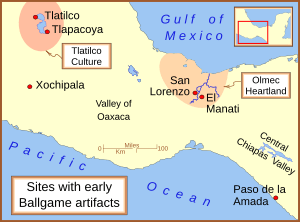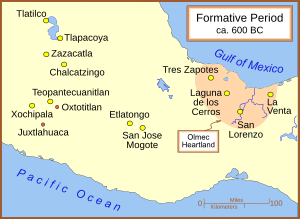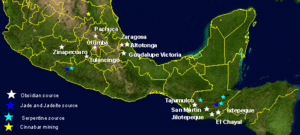Regional communications in ancient Mesoamerica facts for kids
Imagine a time long ago, in a place called Mesoamerica (which includes parts of modern-day Mexico and Central America). People living there weren't isolated! They traveled and traded a lot. This article is all about the amazing ways they communicated and exchanged goods across long distances. We'll especially look at routes that started in the Central Plateau of Mexico and went all the way down to the Pacific coast and into Central America.
We'll explore these ancient connections from the very earliest times up to the Late Classical Period (around 600 to 900 CE).
Contents
Connecting Ancient Cultures

Experts have found many similarities in the art and cultures of ancient Guatemala and Mexico. These shared ideas and styles can be seen from the Central Plateau of Mexico all the way to the Pacific coast and into Central America. Things like symbols, stone carvings, and other artifacts show these connections. This made researchers wonder: how did these ancient people share so much? The answer points to busy trade routes and communication networks!
Since 1998, studies in eastern Guerrero (a state in Mexico) have uncovered a huge network of roads. These roads wound through the Sierra Madre mountains in Guerrero. They connected towns in Morelos and Puebla to an even longer trade route along the Pacific Coast.
These routes were super important for how southern Mesoamerica grew and developed, both politically and economically. Their importance changed over time, but they were always key.
People traded materials and information between the Central Plateau of Mexico, the Gulf of Mexico, and the Pacific Ocean. We're not entirely sure if people traveled directly (which would have been very long trips, maybe 15 days or more one way!) or if goods were traded from one community to the next, like a relay race. This means people from the mountains might never have met people from the coast directly.
Ancient Roads and Paths
Routes from the Gulf of Mexico mountains and central Oaxaca seem to have been open for travel all the time, even from very early periods. However, the Pacific route sometimes faced blockages. For example, between Chiapas and Oaxaca, the Mixtec kingdom of Tututepec controlled parts of the route just before the Spanish arrived. This kingdom tried to control trade for its own benefit.
Ancient Mesoamerican roads were simple dirt paths. They were often full of stones and surrounded by thick plants, as described by a historian named Fray Bernardino de Sahagún. Today, most of these old roads are gone. Modern roads, railways, or just nature (like erosion and plants growing over them) have made them disappear.
But thanks to archaeological studies, we know these important road networks existed. They connected sites in Morelos and southern Puebla with the Pacific Ocean coast, creating a big network for trade and communication.
Main Trade Routes
Many routes connected central Mexico with the Pacific Coast of Guatemala. There were two main paths: one through Puebla and the mountains, and another through the state of Guerrero and along the Pacific Ocean coast. Both of these routes met up at a place called Juchitán. From Juchitán, there were two more routes into Guatemala. One went north towards Mixco-Kaminaljuyu, and the other went south towards Escuintla.
North Route: Tenochtitlan to Juchitán
This route started in Tenochtitlan (the capital of the Aztec Empire, now Mexico City). It went through Puebla, Cholula, and Orizaba. Then it went down the "Eastern Sierra Madre" mountains to Tuxtepec and Matias Romero, finally reaching the Isthmus of Tehuantepec.
There was also another way from Cholula. It went south towards Tehuacán, Oaxaca, and Monte Albán, before heading down to Juchitán.
Middle Route: Tenochtitlan to Juchitán
This route went through Oaxaca and had two options:
- One path went through the Tehuacán Valley, passing through the Cuicatlán and Teotitlán Ravine.
- Another path went through the Morelos Valley and then through the Lower Mixteca region, passing places like Huajuapan de León, and the Mixteca Alta region, including Yanhuitlán and Nochistlán.
From the central valleys of Oaxaca, this route continued towards Nejapa and Tequisistlán, arriving at Tehuantepec and then Juchitán.
South Route: Tenochtitlan to Juchitán
This route also started in Tenochtitlan, heading south to Morelos and Chalcatzingo. It then went east into the state of Guerrero, passing through towns like Chiautla, Huamuxtitlán, Tlapa, and Ometepec. From there, it went towards the "Sierra Madre del Sur" mountains and the coast, passing through Tututepec and Huatulco all the way to Tehuantepec.
Routes from Juchitán to Guatemala
Once at Juchitán, travelers had two main ways to get to Guatemala: a northern route and a southern route.
- The northern route went from Juchitán to Tapanatepec. Then it headed towards "Chiapa de los Indios" (Chiapa de Corzo) and on to Comitán. Once in Guatemala, it continued to Huehuetenango, Quetzaltenango, Chimaltenango, and Mixco Viejo.
- The southern route, also called the Soconusco route, continued from Tapanatepec to Tonalá, Pijijiapan, and Tuxtla Chico. In Guatemala, it went to Retalhuleu and down to Santa Lucía Cotzumalguapa and Escuintla.
Even though these routes were very important, sometimes travel was difficult. The Mixtec Kingdom of Tututepec, for example, tried to control these routes. They wanted to benefit from the trade, which caused problems and tension with other powerful groups, especially the Triple Alliance (the Aztec Empire).
See also
 In Spanish: Comunicaciones regionales en la antigua Mesoamérica para niños
In Spanish: Comunicaciones regionales en la antigua Mesoamérica para niños



